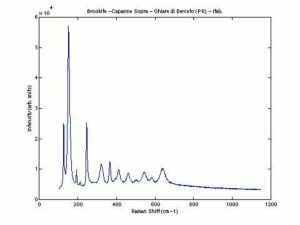Difference between revisions of "Brookite"
Jump to navigation
Jump to search
| Line 2: | Line 2: | ||
== Description == | == Description == | ||
| − | One of three naturally occuring isomorphic forms of [[titanium dioxide]]: anatase, rutile and brookite. Brookite forms red-brown or blackish crystals with a metallic luster. It was named for the English mineralogist H.J.Brooke. Brookite deposits occur in the Alps and in Wales (Fronolen). | + | One of three naturally occuring isomorphic forms of [[titanium dioxide]]: [[anatase]], [[rutile]] and brookite. Brookite forms red-brown or blackish crystals with a metallic luster. It was named for the English mineralogist H.J.Brooke. Brookite deposits occur in the Alps and in Wales (Fronolen). |
== Synonyms and Related Terms == | == Synonyms and Related Terms == | ||
Latest revision as of 10:22, 29 August 2020
Description
One of three naturally occuring isomorphic forms of Titanium dioxide: Anatase, Rutile and brookite. Brookite forms red-brown or blackish crystals with a metallic luster. It was named for the English mineralogist H.J.Brooke. Brookite deposits occur in the Alps and in Wales (Fronolen).
Synonyms and Related Terms
titanium dioxide; brookiet (Ned.); brukit (Pol.); brookita (Port.); brokita (Esp.); Brookit (Deut.)
Physical and Chemical Properties
Orthorhombic crystalline system.
| Composition | TiO2 |
|---|
Resources and Citations
- Encyclopedia Britannica, http://www.britannica.com Comment: brookite" [Accessed January 22, 2002].
- Wikipedia: http://en.wikipedia.org/wiki/Brookite (Accessed Sept. 2, 2005 for foreign language terms)
- Van Nostrand's Scientific Encyclopedia, Douglas M. Considine (ed.), Van Nostrand Reinhold, New York, 1976
- Random House, Webster's Encyclopedic Unabridged Dictionary of the English Language, Grammercy Book, New York, 1997
- The American Heritage Dictionary or Encarta, via Microsoft Bookshelf 98, Microsoft Corp., 1998

